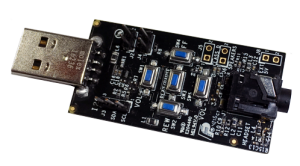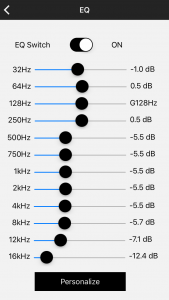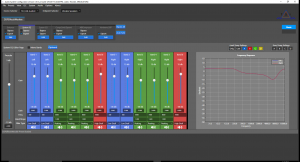The TDTSI016 Reference Design – USB “Type-X” to Stereo 3W Speaker / Headset / Headphone / Line Out: More power, near universal acceptance…
Traditionally, audio accessory OEM / ODMs only had to focus on doing one thing: Making excellent, sounding portable audio accessory products.
The advent of the new USB Type-C port along with the near simultaneous disappearance of the 3.5mm analog audio jack from mobile devices has brought about a whole new host of market opportunities… as well as whole host of challenges for these companies.
 While nearly identical to the available TDTSI010 reference design with respect to functionality, the new TDTSI016 enables the designer to evaluate ANY type of USB connection (USB Type-A, Type-B, Type-C) on most ANY type of device running almost ANY type of OS, all while also enabling access to the I2C bus headers simplifying development of higher-integration designs, larger “more finger friendly” push buttons, off-board power supply support & the 3W stereo capable speaker outputs of the TSCS42xx codec (which is a superset of the TSCS25xx codec).
While nearly identical to the available TDTSI010 reference design with respect to functionality, the new TDTSI016 enables the designer to evaluate ANY type of USB connection (USB Type-A, Type-B, Type-C) on most ANY type of device running almost ANY type of OS, all while also enabling access to the I2C bus headers simplifying development of higher-integration designs, larger “more finger friendly” push buttons, off-board power supply support & the 3W stereo capable speaker outputs of the TSCS42xx codec (which is a superset of the TSCS25xx codec).
If you do not need the 3W Stereo Speaker Outputs, we recommend going with the lowest-cost USB-C100 / USB-C101 turn-key module that works with a simple 1-button or 3-button resistor-ladder network that is compliant with the Android 3.5mm Headset specification or TSTDI0101 form factor reference design as shown below. While the TDTSI010 demo board is no longer available for evaluation (as it has been replaced by the lower-cost USB-C100 / USB-C1010 turn-key module) , the reference design files for the TDTSI101 still are available.
While the TDTSI010 is Tempo’s USB-C Headphone / Headset / Female 3.5mm Adapter turn-key reference design, the TDTSI016 is Tempo’s new “USB-X” Headphone / Headset / Female 3.5mm Adapter reference design, and also features the brand new CP2616 – USB to I2S Digital Audio Bridge Controller from SiLabs just like the TDTSI010 reference design and USBC-100 / USBC-101 turn-key modules do.
This highly cost-effective solution is targeted at Android / Windows / MacOS X / Linux OS-powered mobile / desktop / laptop / tablet devices. The TDTSI016 evaluation board and reference design files are available to all customers upon execution of a mutual NDA.
Spend your resources fine-tuning your mechanical ID, not your microcontroller code
All USB-C based versions of the design employ the CP2616 which saves the OEM / ODM the agony of having to learn and then debug complex microcontroller coding or start from scratch using other vendors “example source code”. Tempo provides the configuration file for the TSCS42xx (as well as the TSCS25xx – the same device that is on the CP2615 Evaluation Board) that is loaded into the SiLabs Express tool. What could be simpler?
Spend your energy focusing on product differentiation, not spinning PCB boards
Naturally, a schematic, BOM, and 4-layer PCB layout files (native and Gerbers) are made available to our customers (just like all other audio IC vendors do), HOWEVER, the design files that Tempo provides have been designed with RoHS, WEEE, CE, FCC and DfM compliance in mind, DRAMATICALLY reducing your Time to Market. Just because others might also have a “reference design” doesn’t mean it is ready to take to production.
Spend your time improving the acoustics, not coding DSPs
Tempo also offers a simple-to-use Windows®-based GUI (Tempo ASC) that enables the acoustical engineer to generate the design-specific DSP “tuning” files (*.PNL). There is even an automatic function that generates the inverse EQ curve from a customer-provided target SPL curve that can be entered into the GUI in minutes. Obtaining a flat frequency response can then be realized within seconds. The generated PNL file is used to help customize the CP2615 configuration file that can be loaded into the end-product via the Android app (which would then reside inside the CP2615 Flash memory) or via the CP2615 Evaluation Board. (Note: Flash memory is not accessible inside the USB-C100 / USB-C101 modules. Speaker tuning / Content EQ is handled by the Android app and any user or factory provided settings are reset upon removal of power.)
Spend your money on your product launch campaign, not hiring an App Developer
The TempoMax Android App delivers both NRE and Lifetime Support savings, not to mention halving your product development timeline!
Naturally, Tempo supports requests for OEM / ODM customization to this Android app included as part of the value that our complete turn-key solution enables.
Why settle for an “analog headset solution” that happens to use a USB-C connector? Go digital, or go home!
 The TempoMax Android App enables a whole host of additional features that enable the OEM / ODM to enable a differentiated product that goes far beyond what other solutions offer today!
The TempoMax Android App enables a whole host of additional features that enable the OEM / ODM to enable a differentiated product that goes far beyond what other solutions offer today!
Hand over the power of a customizable 12-band graphic EQ or even fully user-configurable 12-band parametric EQ to your customer and watch your product sales numbers soar above the sound of the rest!
What about Google Android 5.0 ~ 8.0+? It works perfectly!
What about being able to calling up the Google Voice Assistant via a long-press of the Pause / Play button even if you are not using Android 8.0 “Oreo” or via a separate discrete button on your design? We have you covered!
Running Windows XP / 7 / 8 / 8.1 / 10 on your PC with USB-C? Plug-and-play.
What about your new MacBook, MacBook Pro, iMac or iMac Pro running the latest version of Mac OS X? Bring it on!
Running RedHat on your PC? No problem.
Raspbian running on your Raspberry Pi3? Fine.
Please contact sales@temposemi.com if you are interested in learning more about the TDTSI016 or TDTSI010 reference designs, evaluating the TDTSI016 Demo Board or the USB-C100 / USBC-101 turn-key module or obtaining up to 10 samples of the TSCS42xx CODEC (used on the TDTSI016) or TSCS25xx CODEC (used on the TDTSI010) free of charge.
FYI – Just in case you may have some legacy documentation (TDTSI016 reference schematic or TSCS42xx data sheet), please note that there is no 40-pin QFN offering of the TSCS42xx, only a 48-pin QFN offering. Furthermore, the TSCS25xx is only offered in a 40-pin QFN offering.


